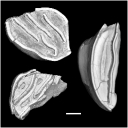















| Plane | Position | Flip |
| Show planes | Show edges |
0.0
M3#639
Fragment of lower molar (most of the mesial part). This isolated broken tooth was scanned with a resolution of 6 µm using a μ-CT-scanning station EasyTom 150 / Rx Solutions (Montpellier RIO Imaging, ISE-M, Montpellier, France). AVIZO 7.1 (Visualization Sciences Group) software was used for visualization, segmentation, and 3D rendering. The specimen was prepared within a “labelfield” module of AVIZO, using the segmentation threshold selection tool.
Data citation:
Laurent Marivaux , Jorge Velez-Juarbe
and Pierre-Olivier Antoine
, 2020. M3#639. doi: 10.18563/m3.sf.639
Model solid/transparent

|
3D models related to the publication: Early Oligocene chinchilloid caviomorphs from Puerto Rico and the initial rodent colonization of the West IndiesLaurent Marivaux, Jorge Velez-Juarbe and Pierre-Olivier AntoinePublished online: 07/09/2020Keywords: Caribbean islands; Caviomorpha; Paleobiogeography; Paleogene; Rodentia https://doi.org/10.18563/journal.m3.127 Abstract This contribution contains the 3D models of the fossil teeth of two chinchilloid caviomorph rodents (Borikenomys praecursor and Chinchilloidea gen. et sp. indet.) discovered from lower Oligocene deposits of Puerto Rico, San Sebastian Formation (locality LACM Loc. 8060). These fossils were described and figured in the following publication: Marivaux et al. (2020), Early Oligocene chinchilloid caviomorphs from Puerto Rico and the initial rodent colonization of the West Indies. Proceedings of the Royal Society B. http://dx.doi.org/10.1098/rspb.2019.2806 M3 article infos Published in Volume 06, issue 04 (2020) |
|